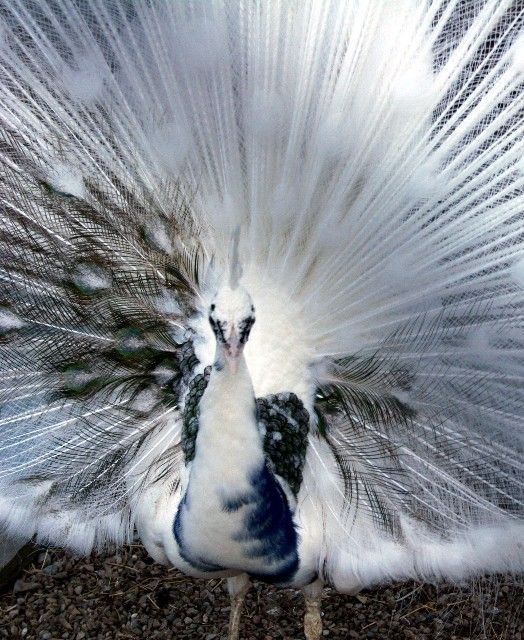Chicken, what you are seeing is probably just nicely colored silver pieds. The silver pied pattern mutation is theorized to be the result of an interaction between pied, white, and white-eye genes. Because the migration of the pigment cells is random in location, the blue (or other colors) on the birds is correspondingly random.
Kedreeva, now I'm curious. You said that you want a white out of a silver pied pair. What makes them different than a 'regular' white? Then you said that you don't like white peafowl in appearance, why would you want one out of a SP pair? While I suspect the answer to both questions is linked, I really do want to know.
I'm not attacking, I am just really curious. Especially since I got a silver pied hen and a dark pied cock almost 4 years ago, 2 years ago a chicken hen hatched out one of their eggs and it's a silver pied cock. Last year I had no luck with their eggs in an incubator. I have the three peas in with my chickens (I am still short a building after one collapsed under snow in early 2011). The silver pied cock is now a 2 year old and seems more dominant than his father is. The hen only laid 4 eggs this year and I have them in my new Brinsea Octagon EX (which I bought specifically for my more 'precious' eggs like peafowl). They are 2 weeks along and I see movement in all 4!!! I am hoping for a white since my personal taste is that I love the elegant simplicity of the whites. Now I want to know what would make a white different if there is a chance that the 'baby' is the dad? I thought they would be 'just' whites.
^_^ I know you're not attacking! I am happy to try to answer questions and glad people are willing to ask them and learn about these birds.
The answer to your first questions about what makes them different from a regular white is that white is not technically a color at all. White is the result of a genetic condition which
doesn't genetically change what color or patterns the bird has. So, say you had two blue blackshoulders that were both split white and one of the babies was white in color. That bird is still genetically a blue blackshoulder bird (even though its feathers would all be white), and bred to a blackshoulder would produce blue blackshoulder chicks (split white). Where as, lets say you took two opal split white birds and bred them together and they produced a white chick- that chick is still genetically an opal bird (even though, again, its feathers would all be white), and bred to an opal, would produce opal chicks (split white). Now say you bred that the white from opal split whites bred to the white from the blue blackshoulder split whites (so two white birds together), they would produce birds that look white, but genetically you would have blue split opal and blackshoulder. Now my head is spinning haha
That being said, yes, a white bird from silver pied parents is vastly different than a white bird out of other parents. A white bird from a pair of silver pied parents bred to a dark pied out of silver pied parents would produce 100% silver pied children, as opposed to when you breed 2 silver pieds (like yours) where you would be getting an assortment of silver pied, dark pied, and whites from those eggs. I really enjoy the silver pieds (and regular pieds). My dark pied hen is from silver pied parents, thus I would like a white boy from silver pied parents to put over her to produce the silver pieds that I want without the whites.
At the end of all that, your question about will it make a difference if the baby silver pied is the father (assuming you bred silver pied hen to silver pied son), then yes.





